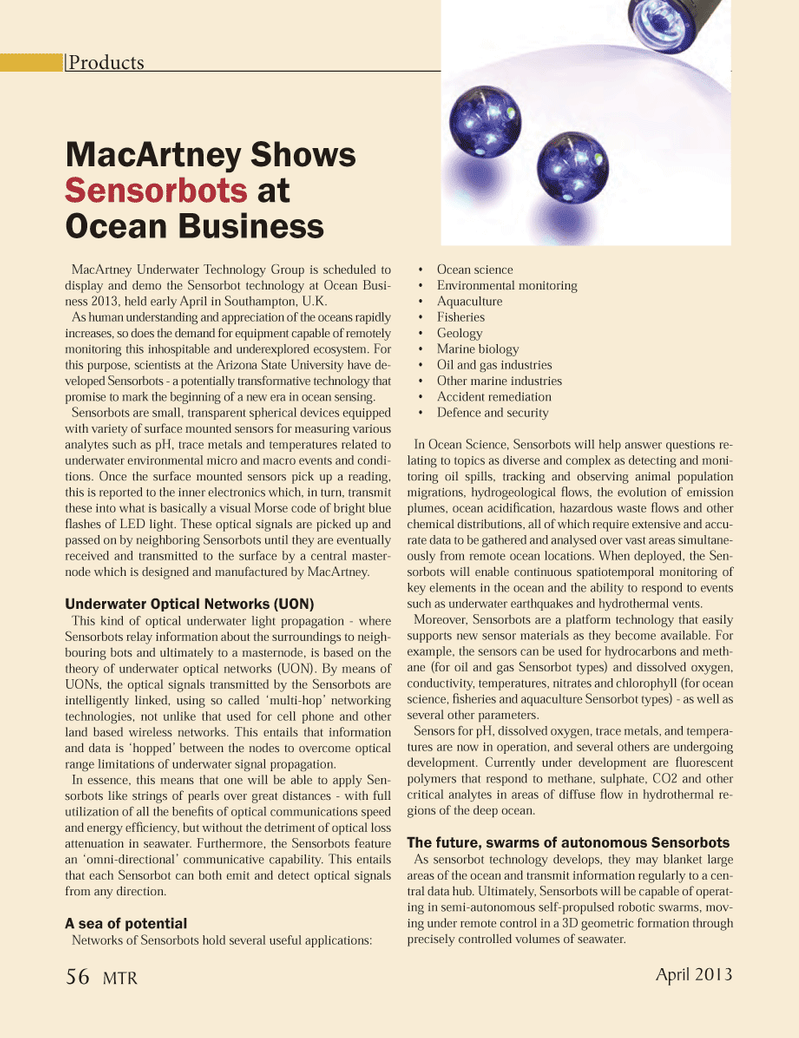
Page 56: of Marine Technology Magazine (April 2013)
Offshore Energy Report
Read this page in Pdf, Flash or Html5 edition of April 2013 Marine Technology Magazine
MacArtney Underwater Technology Group is scheduled to display and demo the Sensorbot technology at Ocean Busi-ness 2013, held early April in Southampton, U.K. As human understanding and appreciation of the oceans rapidly increases, so does the demand for equipment capable of remotely monitoring this inhospitable and underexplored ecosystem. For this purpose, scientists at the Arizona State University have de- veloped Sensorbots - a potentially transformative technology that promise to mark the beginning of a new era in ocean sensing. Sensorbots are small, transparent spherical devices equipped with variety of surface mounted sensors for measuring various analytes such as pH, trace metals and temperatures related to underwater environmental micro and macro events and condi- tions. Once the surface mounted sensors pick up a reading, this is reported to the inner electronics which, in turn, transmit these into what is basically a visual Morse code of bright blue ß ashes of LED light. These optical signals are picked up and passed on by neighboring Sensorbots until they are eventually received and transmitted to the surface by a central master- node which is designed and manufactured by MacArtney. Underwater Optical Networks (UON) This kind of optical underwater light propagation - where Sensorbots relay information about the surroundings to neigh-bouring bots and ultimately to a masternode, is based on the theory of underwater optical networks (UON). By means of UONs, the optical signals transmitted by the Sensorbots are intelligently linked, using so called Ômulti-hopÕ networking technologies, not unlike that used for cell phone and other land based wireless networks. This entails that information and data is ÔhoppedÕ between the nodes to overcome optical range limitations of underwater signal propagation. In essence, this means that one will be able to apply Sen-sorbots like strings of pearls over great distances - with full utilization of all the beneÞ ts of optical communications speed and energy efÞ ciency, but without the detriment of optical loss attenuation in seawater. Furthermore, the Sensorbots feature an Ôomni-directionalÕ communicative capability. This entails that each Sensorbot can both emit and detect optical signals from any direction. A sea of potentialNetworks of Sensorbots hold several useful applications: ¥ Ocean science ¥ Environmental monitoring ¥ Aquaculture¥ Fisheries¥ Geology¥ Marine biology ¥ Oil and gas industries ¥ Other marine industries ¥ Accident remediation ¥ Defence and security In Ocean Science, Sensorbots will help answer questions re-lating to topics as diverse and complex as detecting and moni- toring oil spills, tracking and observing animal population migrations, hydrogeological ß ows, the evolution of emission plumes, ocean acidiÞ cation, hazardous waste ß ows and other chemical distributions, all of which require extensive and accu- rate data to be gathered and analysed over vast areas simultane- ously from remote ocean locations. When deployed, the Sen- sorbots will enable continuous spatiotemporal monitoring of key elements in the ocean and the ability to respond to events such as underwater earthquakes and hydrothermal vents. Moreover, Sensorbots are a platform technology that easily supports new sensor materials as they become available. For example, the sensors can be used for hydrocarbons and meth- ane (for oil and gas Sensorbot types) and dissolved oxygen, conductivity, temperatures, nitrates and chlorophyll (for ocean science, Þ sheries and aquaculture Sensorbot types) - as well as several other parameters. Sensors for pH, dissolved oxygen, trace metals, and tempera- tures are now in operation, and several others are undergoing development. Currently under development are ß uorescent polymers that respond to methane, sulphate, CO2 and other critical analytes in areas of diffuse ß ow in hydrothermal re- gions of the deep ocean. The future, swarms of autonomous Sensorbots As sensorbot technology develops, they may blanket large areas of the ocean and transmit information regularly to a cen- tral data hub. Ultimately, Sensorbots will be capable of operat- ing in semi-autonomous self-propulsed robotic swarms, mov- ing under remote control in a 3D geometric formation through precisely controlled volumes of seawater. Products MacArtney Shows Sensorbots at Ocean Business April 201356 MTRMTR #3 (50-64).indd 56MTR #3 (50-64).indd 564/3/2013 4:38:34 PM4/3/2013 4:38:34 PM

 55
55

 57
57
